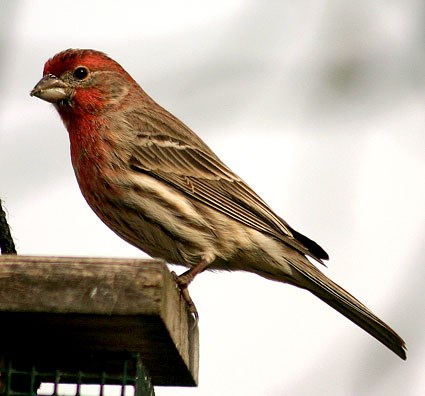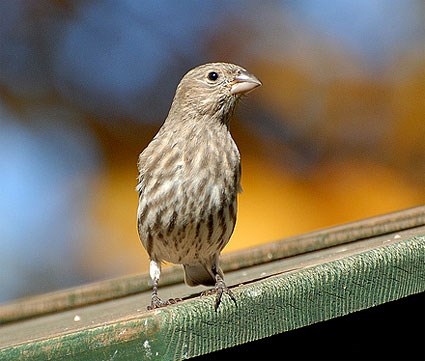






- Total
- General
- Arts
- Book
- Culture
- Economy
- Essay
- Fun/Joke
- History
- Hobbies
- Info
- Life
- Medical
- Movie
- Music
- Nature
- News
- Notice
- Opinion
- Philosophy
- Photo
- Poem
- Politics
- Science
- Sports
- Travel
Life Facts about House Finch
2012.08.09 05:25
| House Finch
The House Finch was originally a bird of the western United States and Mexico. So the more pigment in the food, the redder the male. This is why people sometimes see orange or yellowish male House Finches. Females prefer to mate with the reddest male they can find, perhaps raising the chances they get a capable mate who can do his part in feeding the nestlings. Since January 1994, House Finches have been detected with a disease called mycoplasmal conjunctivitis that causes respiratory problems and red, swollen eyes. It can kill House Finches directly or make them easy prey. House Finch conjunctivitis was first observed at feeders in the Washington, D.C., area. It’s not harmful to humans, but it has spread rapidly through the eastern House Finch population and into the West.
In their native range in the West, House Finches live in natural habitats including dry desert, desert grassland, chaparral, oak savannah, streamsides, and open coniferous forests at elevations below 6,000 feet. Nesting Habits The female lays 2 to 6 bluish with fine speckling eggs. Incubation is done by the female for 12 to 14 days and the young will leave the nest in about 11 to 19 days after hatching. During the incubation time and for about five days after the young have hatched, the male, will feed the female on the nest. He does this by regurgitating seed into the females mouth. The female regurgitates the food to the nestlings. After the young have fledged, the parents continue to feed the young. The female may find a new mate and raise another brood while the male continues to feed the young. House finches have been known to raise more than two broods in a season. In response to mite infestation, the mother finch may lay one gender of egg first, which increases the chances of the young finches' survival. The female incubates the eggs for 12 to 14 days. Shortly after hatching, she removes the empty eggshells from the nest. The hatchlings are pink with closed eyes and tufts of fluffy down. The female always feeds the young, and the male usually joins in. Before flying, the young often climb into adjacent plants, and usually fledge at about 11 to 19 days after hatching. Dandelion seeds are among the preferred seeds fed to the young. House Finches are aggressive enough to drive other birds away from places such as feeders. Data from the Internet |
Comment 3
-
운영자
2012.08.09 05:54
-
운영자
2012.08.10 08:04
House Finch - Additional Information Nesting Habits
Although bird watchers may see the male with nesting material, the female builds the actual nest.
The nest is cup shaped and made of twigs, grasses, and leaves. These finches will nest in a variety of artificial and natural cavites such as old woodpecker holes, hanging plants, and occasionally birdhouses. The nest is located 5 to 10 feet above ground.The female lays 2 to 6 bluish with fine speckling eggs. Incubation is done by the female for 12 to 14 days and the young will leave the nest in about 11 to 19 days after hatching.
During the incubation time and for about five days after the young have hatched, the male, will feed the female on the nest. He does this by regurgitating seed into the females mouth. The female regurgitates the food to the nestlings.
After the young have fledged, the parents continue to feed the young. The female may find a new mate and raise another brood while the male continues to feed the young.
House finches have been known to raise more than two broods in a season.
Breeding
During courtship, the male will touch bills with the female. He may then present the female with choice bits of food, and if she mimics the behavior of a hungry chick, he may actually feed her. The male also feeds the female during the breeding and incubation of both eggs and young, and the male is the primary feeder of the fledgelings (who can be differentiated from the females by the pin feathers remaining on their heads).
The female lays clutches of eggs from February through August, two or more broods per year with 2 to 6 eggs per brood, most commonly 4 or 5. The egg laying usually takes place in the morning, at the rate of one egg per day. The eggs are a pale bluish green with few black spots and a smooth, somewhat glossy surface.In response to mite infestation, the mother finch may lay one gender of egg first, which increases the chances of the young finches' survival. The female incubates the eggs for 12 to 14 days.
Shortly after hatching, she removes the empty eggshells from the nest. The hatchlings are pink with closed eyes and tufts of fluffy down. The female always feeds the young, and the male usually joins in.
The young are silent for the first seven or eight days, and subsequently start peeping during feedings. Initially, the mother carries fecal sacs out of the nest, but when the young become older, she no longer carries them all away, allowing droppings to accumulate around the edge of the nest.Before flying, the young often climb into adjacent plants, and usually fledge at about 11 to 19 days after hatching. Dandelion seeds are among the preferred seeds fed to the young. House Finches are aggressive enough to drive other birds away from places such as feeders.
Data from the Internet
-
이한중*65
2012.08.10 10:16
Thank you, WM, for your ornithology lecture on finch.
I've learned a lot.
| No. | Subject | Date | Author | Last Update | Views |
|---|---|---|---|---|---|
| Notice | How to write your comments onto a webpage [2] | 2016.07.06 | 운영자 | 2016.11.20 | 18193 |
| Notice | How to Upload Pictures in webpages | 2016.07.06 | 운영자 | 2018.10.19 | 32344 |
| Notice | How to use Rich Text Editor [3] | 2016.06.28 | 운영자 | 2018.10.19 | 5922 |
| Notice | How to Write a Webpage | 2016.06.28 | 운영자 | 2020.12.23 | 43838 |
| 8842 | 훈민정음의 비밀 [4] | 2024.04.25 | 운영자 | 2024.04.29 | 49 |
| 8841 | 부산정치파동과 미국의 이승만 제거계획 | 2024.04.25 | 온기철*71 | 2024.04.25 | 18 |
| 8840 | 코너킥으로 웃었다... 황선홍호, 일본 제압하고 8강으로 [5] | 2024.04.22 | 황규정*65 | 2024.04.25 | 29 |
| 8839 | [시조]懷古歌: 회고가 [1] | 2024.04.21 | 정관호*63 | 2024.04.21 | 10 |
| 8838 | 부산형무소 살해사건 | 2024.04.20 | 온기철*71 | 2024.04.20 | 17 |
| 8837 | 육군 방첩대. 미군 CIC, 그리고 김창룡 | 2024.04.17 | 온기철*71 | 2024.04.25 | 20 |
| 8836 | 김구의 일생과 암살의 원인 | 2024.04.14 | 온기철*71 | 2024.04.25 | 18 |
| 8835 | OPERA MIGNON: Connais tu le pays [1] | 2024.04.12 | 정관호*63 | 2024.04.12 | 25 |
| 8834 | “쏘니,너와 함께 뛴건 행운!”, 400경기 감동 축하영상 [5] | 2024.04.06 | 황규정*65 | 2024.04.22 | 33 |
| 8833 | 길에서 만난 한식 [1] | 2024.04.03 | 정관호*63 | 2024.04.09 | 33 |
| 8832 |
돌아오는 기러기
[1] | 2024.03.27 | 정관호*63 | 2024.04.18 | 46 |
| 8831 | 이강인-손흥민 ‘골 합작’ 한국, 태국 3-0 완승…월드컵 최종 예선 진출 성큼 [2] | 2024.03.26 | 황규정*65 | 2024.03.27 | 43 |
| 8830 | 1945년 8월 15일 오후 강릉 홍제정 안마을에서 [2] | 2024.03.19 | 정관호*63 | 2024.03.24 | 76 |
| 8829 | 이승만은 왜 김구를 제거 했을까? [1] | 2024.03.17 | 온기철*71 | 2024.03.18 | 52 |
| 8828 | My Grandson [1] | 2024.03.15 | 노영일*68 | 2024.03.18 | 107 |
| 8827 | 蜀相(촉상): 촉한 승상 제갈량 [1] | 2024.03.15 | 정관호*63 | 2024.04.12 | 59 |
| 8826 | 1945년 8월15일에는 서울에 아무일도 없었다. [1] | 2024.03.13 | 온기철*71 | 2024.03.14 | 53 |
| 8825 | 왕소군 고향에서 [1] | 2024.03.08 | 정관호*63 | 2024.03.20 | 57 |
| 8824 | 정약용; 늙어가면 친구가 점점 없어진다. [5] | 2024.03.06 | 온기철*71 | 2024.03.08 | 86 |
| 8823 | Trump is OK to be a candidate. | 2024.03.04 | 온기철*71 | 2024.03.17 | 55 |



 Habitat
Habitat Food
Food Nest Placement
Nest Placement
It is somewhat unusual that they are vegetarians and don't eat worms like other birds.
They mainly eat seeds. No wonder they always take over the bird feeders with seeds at my home.
In that case, the mother bird has to regurgitate to feed her babies.
I was surprised to find a phrase that "They build their nest on Christmas wreaths."
Our wreath wasn't for Christmas but they wouldn't know the difference.
I am glad that I get to know them a little better.
고향의 참새: 크기와 모양이 비슷하게 보이지만,
우리가 알고있는 한국의 "참새"와는 다른 새종류이다.
물론 같은 family에 속할지는 모르지만.
여기의 참새 사진을 자세히 보면 전혀 다르다는것을 알수있다.
참새는 Asia와 Europe에 있고 미주대륙에는 없는것으로 되어있다.
우리가 아는 한국의 참새는 영어로 Eurasian Sparrow, True Sparrow, or Old World Sparrow이며,
American Sparrow와는 Family가 다른 종류라한다.